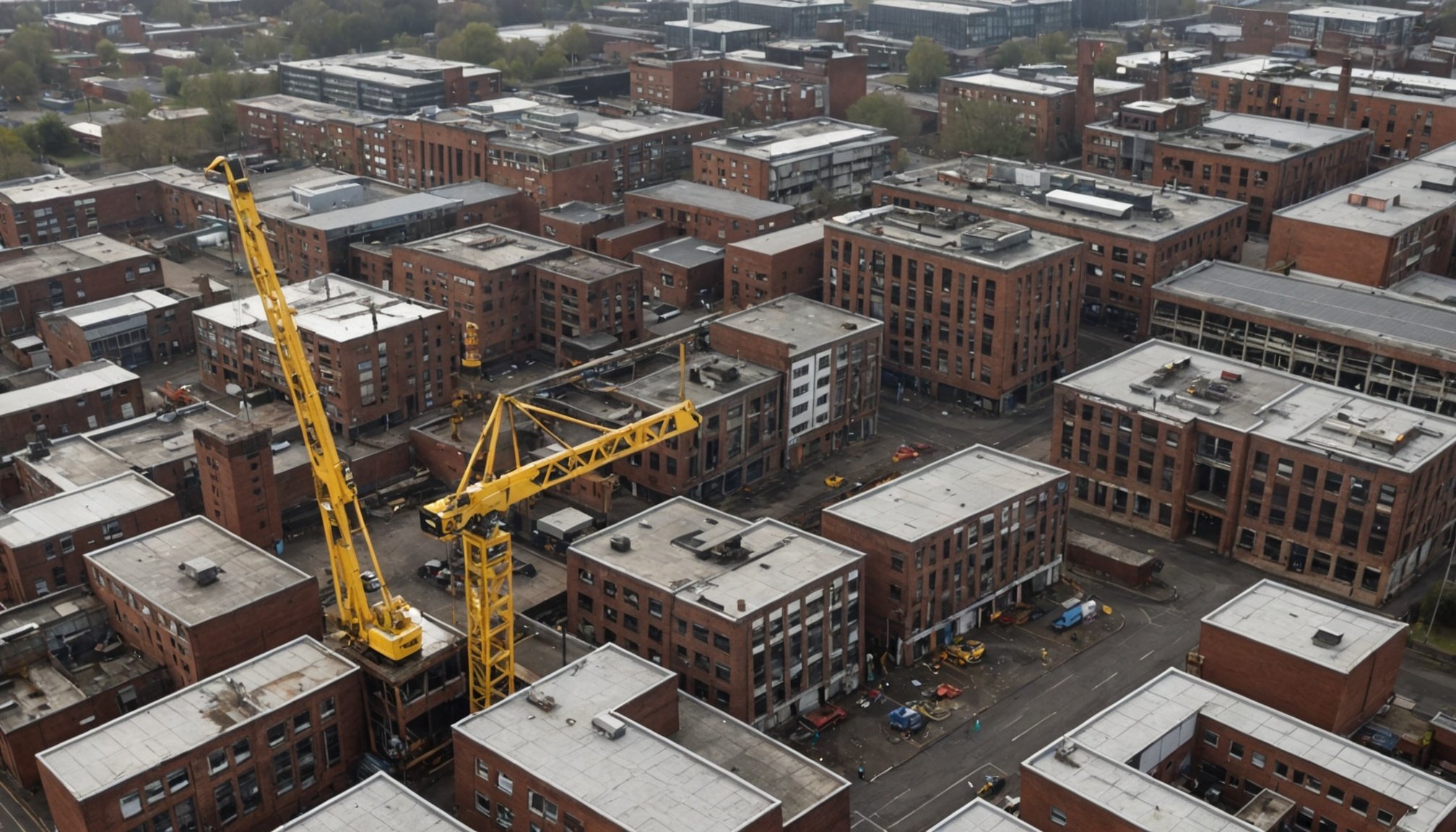Your Guide to Securing Brownfield Redevelopment Funding in the Midlands
Understanding Brownfield Sites and Their Potential
Brownfield sites, often referred to as previously developed land, are areas that have been used before but are now disused or derelict. These sites, commonly found in urban and industrial areas, have a rich history of use for various industrial and commercial purposes, such as coal mining, chemical works, and landfill sites. However, this past use has often left behind a legacy of contamination, making these sites challenging to redevelop.
In the Midlands, where industrial heritage is profound, brownfield sites are abundant. For instance, a former coal-mining site in Stoke-on-Trent has recently been approved for redevelopment into 320 homes, highlighting the potential of these sites for new housing and community development.
In parallel : How can international investors enter the UK property market successfully?
The Need for Brownfield Redevelopment
The UK is facing a significant housing shortage, and brownfield sites offer a crucial solution. By redeveloping these sites, local authorities and developers can provide much-needed housing while also revitalizing neglected areas and promoting sustainable urban growth.
Prime Minister Keir Starmer has emphasized the government’s “brownfield-first approach,” aiming to transform disused sites and industrial wastelands into thousands of new homes. This approach not only addresses the housing crisis but also helps in environmental cleanup and community regeneration.
This might interest you : Unlocking UK Property Mortgages: Essential Tips for Self-Employed Individuals to Enhance Approval Odds
Securing Funding for Brownfield Redevelopment
Securing funding is a critical step in the brownfield redevelopment process. Here are some key sources and strategies to consider:
Government Funding Initiatives
The UK government has introduced several funding initiatives to support brownfield redevelopment. One of the most significant is the Brownfield Land Release Fund, which provides financial support to local authorities to cover the costs of decontamination, clearing disused buildings, and improving infrastructure.
For example, £68 million has been allocated to 54 councils across England to unlock disused brownfield sites and build approximately 5,200 new homes. Cities like Manchester, Eastbourne, and Northampton are among the beneficiaries, with funding ranging from £1.4 million to £3 million for specific projects.
Homes England and Housing Infrastructure Fund
Homes England, the government’s housing agency, plays a vital role in supporting brownfield redevelopment. The Housing Infrastructure Fund (HIF) is another key initiative that helps facilitate housing development on challenging brownfield sites.
In Stoke-on-Trent, the redevelopment of a former coal-mining site is contingent upon securing £3.8 million from Homes England. This funding will be used for significant remediation work, including drilling boreholes and sealing mineshafts to stabilize the ground and remove hazardous substances like arsenic and mercury.
Steps to Secure Funding
Here are some practical steps developers and local authorities can take to secure funding for brownfield redevelopment:
-
Conduct Preliminary Work: Developers should conduct thorough site assessments to understand the extent of contamination and the required remediation activities. This preliminary work can be done at the developer’s own cost to demonstrate commitment and readiness for the project.
-
Engage with Local Authorities: Building strong relationships with local authorities is crucial. They can provide valuable insights into available funding opportunities and help navigate the planning permission process.
-
Apply for Government Grants: Developers should be aware of and apply for relevant government grants, such as those offered through the Brownfield Land Release Fund or the Housing Infrastructure Fund.
-
Collaborate with Experts: Partnering with experts in environmental biotechnology, like the British Geological Survey (BGS) and Arcadis, can provide innovative solutions for site cleanup using natural biological processes. This can make the redevelopment more sustainable and cost-effective.
Case Studies: Successful Brownfield Redevelopment Projects
Stoke-on-Trent: Former Coal-Mining Site
The approval for 320 homes on a former coal-mining site in Stoke-on-Trent is a prime example of successful brownfield redevelopment. The project involves significant remediation work, including drilling 1,837 boreholes to stabilize the ground and remove hazardous substances. The site will feature 227 houses and 93 care-at-home apartments, with access provided via an enhanced junction on Scotia Road.
Manchester: Vacant Brownfield Site
Manchester is set to benefit from £3 million in funding to unlock a vacant brownfield site for the construction of 220 affordable homes. This project exemplifies how targeted funding can transform disused industrial land into vibrant residential areas.
Challenges and Solutions in Brownfield Redevelopment
Environmental Contamination
One of the major challenges in brownfield redevelopment is environmental contamination. Historical industrial processes have left behind harmful byproducts, residues, and wastes that pose significant health and environmental risks.
-
Bioremediation: New research by the BGS and Arcadis explores the use of microorganisms to break down hazardous chemicals like 1,4-dioxane. This biological approach offers a sustainable and cost-effective solution for site cleanup.
-
Infrastructure Improvements: Enhancing existing infrastructure, such as roads and junctions, is essential to support new housing developments. For example, the Stoke-on-Trent project includes plans to enhance the junction on Scotia Road to mitigate potential traffic conflicts.
Community Engagement and Planning
Community engagement and thorough planning are critical for the success of brownfield redevelopment projects.
-
Public Consultations: Conducting public consultations helps in understanding community needs and concerns. This can lead to more inclusive and sustainable development plans.
-
Collaborative Planning: Working closely with local authorities, developers, and community groups ensures that the redevelopment aligns with local needs and policies.
Practical Insights and Actionable Advice
Here are some practical insights and actionable advice for those involved in brownfield redevelopment:
Understand the Site’s History
Before embarking on any redevelopment project, it is crucial to understand the site’s history and the extent of contamination. This involves thorough site assessments and historical research.
Build Strong Partnerships
Developing strong partnerships with local authorities, experts, and community groups is essential. These partnerships can provide access to funding, expertise, and community support.
Stay Updated on Funding Opportunities
Regularly check for new funding initiatives and government grants. Staying informed can help you capitalize on available funds and support your redevelopment plans.
Securing funding for brownfield redevelopment in the Midlands is a complex but rewarding process. By understanding the potential of brownfield sites, leveraging government funding initiatives, and addressing the challenges associated with these sites, developers and local authorities can transform neglected areas into vibrant communities.
As Richard Peel, managing director of Mansion House Group, noted, “We have been in discussions with Homes England for four years and are confident in securing the necessary funding.” This confidence, combined with thorough planning and community engagement, is key to the success of brownfield redevelopment projects.
Detailed Bullet Point List: Steps to Secure Funding for Brownfield Redevelopment
-
Conduct Thorough Site Assessments:
-
Identify the extent of contamination.
-
Determine the required remediation activities.
-
Assess the site’s historical use and potential hazards.
-
Engage with Local Authorities:
-
Build relationships with local council members.
-
Seek guidance on available funding opportunities.
-
Collaborate on planning and community engagement.
-
Apply for Government Grants:
-
Research and apply for grants from the Brownfield Land Release Fund.
-
Explore funding from Homes England and the Housing Infrastructure Fund.
-
Stay updated on new funding initiatives.
-
Collaborate with Experts:
-
Partner with environmental biotechnology experts.
-
Explore innovative solutions for site cleanup.
-
Use biological processes for bioremediation.
-
Enhance Infrastructure:
-
Improve existing roads and junctions.
-
Ensure adequate access and mitigate potential traffic conflicts.
-
Plan for sustainable infrastructure development.
-
Engage in Community Consultations:
-
Conduct public consultations to understand community needs.
-
Incorporate community feedback into development plans.
-
Foster community support through transparent communication.
Comprehensive Table: Funding Allocations for Brownfield Redevelopment Projects
| Location | Funding Amount | Number of Homes | Project Details |
|---|---|---|---|
| Stoke-on-Trent | £3.8 million | 320 homes | Remediation of former coal-mining site, including 227 houses and 93 care-at-home apartments |
| Manchester | £3 million | 220 homes | Redevelopment of a vacant brownfield site for affordable housing |
| Eastbourne | £2.2 million | 100 homes | Construction of 100 new homes, including 80 affordable houses |
| Weston-Super-Mare | £1.7 million | 100 homes | Development of 100 homes in the town centre |
| Northampton | £1.4 million | 72 homes | Transformation of a former bus depot into residential units |
Relevant Quotes
-
“We have been in discussions with Homes England for four years and are confident in securing the necessary funding.” – Richard Peel, Managing Director of Mansion House Group.
-
“While biodegradation of 1,4-dioxane has been demonstrated, the microorganisms responsible for this process remain under-characterised. This research will increase our understanding of microorganisms responsible for 1,4-dioxane biodegradation.” – Dr. Monica Heintz, Geoscientist at Arcadis.
-
“The Government’s ‘brownfield-first approach’ will see ‘disused sites and industrial wastelands transformed into thousands of new homes’.” – Prime Minister Keir Starmer.











